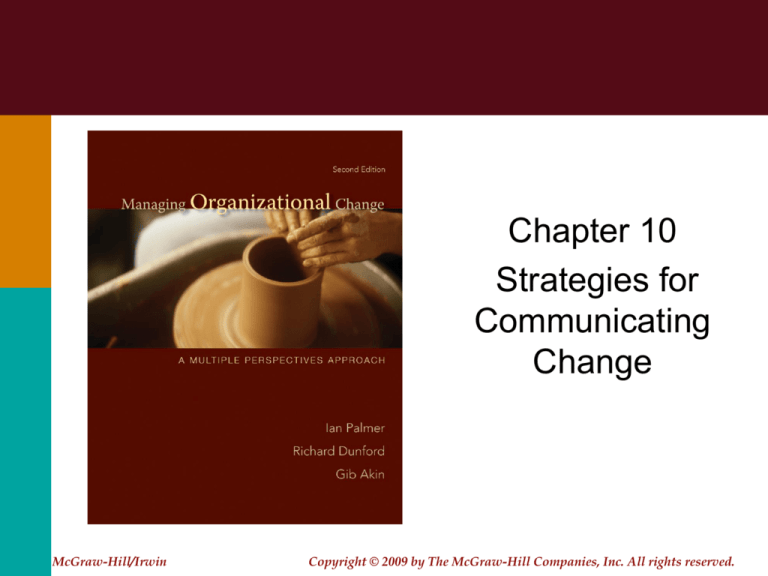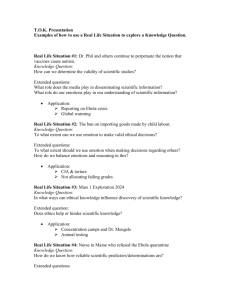
Chapter 10
Strategies for
Communicating
Change
McGraw-Hill/Irwin
Copyright © 2009 by The McGraw-Hill Companies, Inc. All rights reserved.
Images of Managing Change
Images of
Managing Change
Communication
Process
Language, Power,
Gender &
Communication
Emotion &
Communication
Communication
Strategies
- Contingency
approaches
Communication
Media:
-Richness
-Responsibility
Images
Purpose of Communication
Director
Ensure people understand what is going to happen and what is required of them.
Communication strategies need to ensure that there is no message overload or
message distortion
Navigator
Similar to director but pay attention to identifying alternative interests that may
disrupt the proposed change. “Tell and sell” communication techniques are used
to try to win people over to the change.
Caretaker
Focus is on letting people know about the “why” of change, that is, the
inevitability of the changes and how best to cope or survive them. “Identify and
reply” (reactive) communication strategy is used.
Coach
Focus is on ensuring people share similar values and are aware of what actions
are appropriate to these values. The focus of the coach is “getting buy-in” to the
change through shared values and the use of “positive emotions.” “Underscore
and explore” interactions are used to engage in dialogue about the change.
Interpreter
Interpreters provide staff with a sense of “what is going on” through story telling,
metaphors, and so on. They recognize that not all will buy in to the story of
change, but the aim is to provide the most dominant account. “Rich”
communication media are most favored.
Nurturer
The nurturer image leads change managers to reinforce the view that processes
cannot always be predicted and that often outcomes will occur that are innovative
and creative for an organization even though few people could have anticipated
what these might be prior to their occurrence.
10-2
Communication Process
Images of
Managing Change
Communication
Process
Language, Power,
Gender &
Communication
Emotion &
Communication
Communication
Strategies
- Contingency
approaches
Communication
Media:
-Richness
-Responsibility
• The way change is communicated is
important to the success of the change
program
• The communication process, or mix,
includes elements such as content,
voice, tone, message, audience,
medium, frequency and consistency.
• There are many problems can disturb
the process of communication:
– message overload
– message distortion and
– message ambiguity
10-3
Language, Power, Gender & Communication
Images of
Managing Change
Communication
Process
Language, Power,
Gender &
Communication
Emotion &
Communication
Communication
Strategies
- Contingency
approaches
Communication
Media:
-Richness
-Responsibility
• Language, power, gender and emotion can
also impact the communication of change.
• Language reflects and reinforces underlying
social and power relationships.
• Gender differences, for example, also affect
this process. Three examples of the
difference are:
– Getting credit
– Confidence and boasting
– Asking questions
• Other gender differences relate to how
feedback is given and received, how
compliments are exchanged, and whether
the communication is direct or indirect.
10-4
Emotion & Communication
Images of
Managing Change
Communication
Process
Language, Power,
Gender &
Communication
Emotion &
Communication
Communication
Strategies
- Contingency
approaches
Communication
Media:
-Richness
-Responsibility
• Emotion is linked to change, and can
also contribute to the breakdown of the
communication process.
• Individuals can perceive that
organizational change can harm them
personally, thus their emotional state
and sense of identity are threatened
by change situations.
• Managers can use three techniques to
avoid these situations:
– Perspective taking
– Threat-reducing behavior
– Reflection
10-5
Communication Strategies
Images of
Managing Change
Communication
Process
Language, Power,
Gender &
Communication
Emotion &
Communication
Communication
Strategies
- Contingency
approaches
Communication
Media:
-Richness
-Responsibility
• Can you communicate too much:
– depending on the change and the image of the
change manager the level and extent of
communication can vary.
• Getting word out or buy in:
– this differentiates between focusing the
communication process on the provision of
information or gaining participation in the process.
• Beyond Spray and Pray:
– This communication continuum includes five
approaches
• Spray and pray
• Tell and sell
• Underscore and explore
• Identify and reply
• Withhold and uphold
10-6
Communication Strategies
Images of
Managing Change
Communication
Process
Language, Power,
Gender &
Communication
Emotion &
Communication
Communication
Strategies
- Contingency
approaches
Communication
Media:
-Richness
-Responsibility
• Contingency approaches to
communicating strategy vary
depending:
– on the type of change e.g.
• Developmental or incremental
• Task-focused
• Charismatic
• Turnaround (Stace & Dunphy, 2001)
– on the stage of change e.g.
• Planning
• Enabling
• Launching
• Catalyzing
• Maintaining (Reardon & Reardon, 1999)
10-7
Communication Media: Richness
Images of
Managing Change
Communication
Process
Language, Power,
Gender &
Communication
Emotion &
Communication
Communication
Strategies
- Contingency
approaches
Communication
Media:
-Richness
-Responsibility
• Varies in “richness” depending on how
personal is its ability to communicate
change
• There is a hierarchy of media richness
than can be more applicable for
particular situations.
– For example, an email or memo is less
personal (and less “rich”) than a face to
face meeting
Different types of media may also be
more appropriate for different
audiences with differing needs.
10-8
Communication Media: Responsibility
Images of
Managing Change
Communication
Process
Language, Power,
Gender &
Communication
Emotion &
Communication
Communication
Strategies
- Contingency
approaches
Communication
Media:
-Richness
-Responsibility
CEO: Many believe that the CEO
should be the principle communicator
of change while others find lower level
managers more trusted by staff and
therefore in a better position to
communicate change.
Tag Teams: Many organizations now
use tag teams – a transition
management team. The role of this
team is specifically to stimulate open
conversations through organizational
units and dispersing information.
10-9





